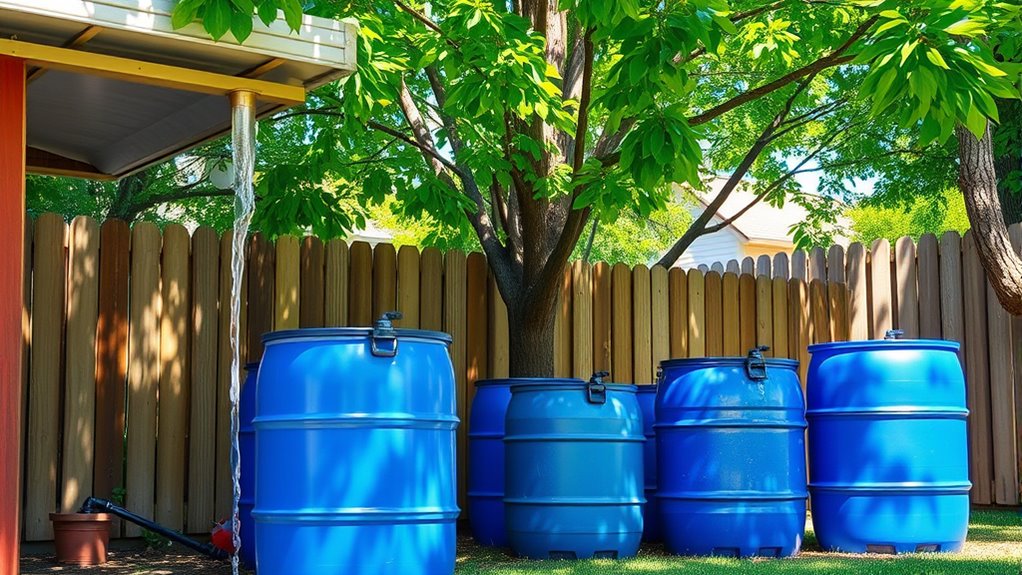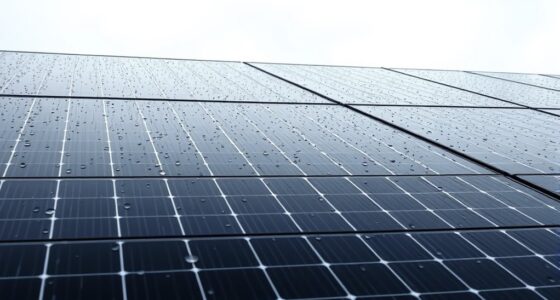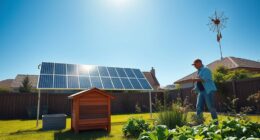Setting up rainwater harvesting barrels in an afternoon is straightforward and budget-friendly. Choose suitable barrels and position them near your downspouts on a stable surface. Attach diverters or screens to filter debris and connect the barrels with spigots for easy access. Cover the barrels to prevent mosquitoes and guarantee maintenance. With simple tools and a bit of effort, you’ll have a functional system that saves water and helps your garden thrive—discover more tips to enhance your setup.
Key Takeaways
- Select suitable barrels and position them on a stable, level surface near downspouts.
- Attach diverters or screens to downspouts to filter debris and direct water into the barrels.
- Install a spigot at the bottom of each barrel for easy access and watering.
- Cover barrels with lids or screens to prevent mosquito breeding and debris entry.
- Regularly check for debris, algae, and proper function to maintain an efficient system.

Have you ever considered how rainwater harvesting barrels can help you save money and conserve resources? Installing these barrels isn’t just a simple DIY project; it also plays a crucial role in stormwater management and sustainable landscaping. By collecting rainwater directly from your roof, you reduce runoff that can overwhelm local drainage systems, preventing erosion and water pollution. Plus, you create a valuable water source for your garden, reducing dependence on municipal supplies and lowering your utility bills.
Setting up your rainwater harvesting system in an afternoon is straightforward and cost-effective. First, choose a suitable barrel—plastic or metal, depending on your aesthetic preference and budget—and position it on a level surface close to your downspout. Make sure the area is stable and accessible for maintenance. Next, modify your downspout by installing a diverter or a screen to filter out debris, leaves, and small animals, ensuring cleaner water collection. You can buy a pre-made diverter kit or craft a simple one with basic tools. Attach the diverter securely to direct rainwater into your barrel, keeping excess water from splashing or overflowing.
To maximize your system’s efficiency, consider adding a lid or screen to keep out mosquitoes and debris. Installing a spigot near the bottom of the barrel allows you to easily access water for watering plants or washing tools. For sustainable landscaping, you’ll find that using collected rainwater promotes healthier plant growth since it’s free of chemicals often found in tap water. It also helps maintain soil moisture during dry spells, reducing the need for supplemental watering and conserving potable water resources. Additionally, understanding stormwater management benefits can motivate proper system design and placement.
Integrating multiple barrels can further enhance stormwater management by increasing your water storage capacity and reducing runoff volume. If you’re looking for a more polished look, you can paint or decorate your barrels to match your outdoor aesthetic. Regularly check and clean your system to prevent algae buildup and ensure water quality. These simple steps make your rainwater harvesting setup efficient, eco-friendly, and easy to maintain.
In just a few hours, you can create a reliable source of free water, cut costs, and contribute to a healthier environment. Your efforts support sustainable landscaping by providing plants with natural rainwater, and they help manage stormwater more effectively. Installing rainwater harvesting barrels is a smart, practical solution that benefits your wallet, your garden, and your community—all with minimal effort and expense.
Frequently Asked Questions
Are Rainwater Harvesting Barrels Safe for Drinking Water?
You wonder if rainwater harvesting barrels are safe for drinking. While they can be, you need to guarantee proper water purification before consumption. Use food-grade barrel materials to prevent contamination. Regularly clean and inspect the barrels, and install effective filtration systems. These steps help remove debris and pathogens, making rainwater safe for drinking. Always test the water quality to confirm it meets health standards before drinking.
How Often Should I Clean and Maintain the Barrels?
Oh, the irony of ignoring barrel cleaning and maintenance schedule—thinking it’ll last forever, right? You should clean your rainwater harvesting barrels at least every 6 months to prevent algae and debris buildup. Regular maintenance, including inspecting for leaks and ensuring covers stay secure, keeps your water safe and your system efficient. Skipping this step might save time initially, but it costs more in the long run.
Can I Connect Multiple Barrels for Larger Storage?
Yes, you can connect multiple barrels for larger storage. Use appropriate connection methods like flexible hoses or spigots to link the barrels securely. Guarantee the barrels are made from durable, UV-resistant materials like polyethylene or metal for longevity. When connecting, position barrels on a stable, level surface, and consider installing a spillway or overflow system. This setup helps expand your rainwater collection and makes maintenance easier.
What Permits or Regulations Apply to Rainwater Harvesting?
When considering rainwater harvesting, you need to understand the legal considerations, including local permitting and zoning restrictions. Check with your city or county regulations, as some areas require permits or have restrictions on the size and placement of your barrels. Zoning restrictions could affect whether you can set up a rainwater collection system and how it’s integrated into your property. Always research local laws to guarantee compliance and avoid potential fines.
How Much Rainfall Is Needed to Make the System Effective?
You might think minimal rainfall limits rainwater collection efficiency, but even small, consistent rains can be effective if your system is designed well. Generally, about 1-2 inches of rainfall per week boosts efficiency, though rainfall variability affects collection. To maximize your system’s potential, monitor local weather patterns, and optimize barrel size and placement. Small, frequent rains can still provide significant water savings over time.
Conclusion
Now that you’ve set up your rainwater harvesting barrel in just an afternoon, you’re ready to save water and money. Remember, “A little water saves a lot,” so keep your barrel maintained and use the collected rainwater wisely. With your new system, you’re not only helping the environment but also enjoying a simple, rewarding DIY project. Stay resourceful, and let every drop count toward a greener, more sustainable future.









